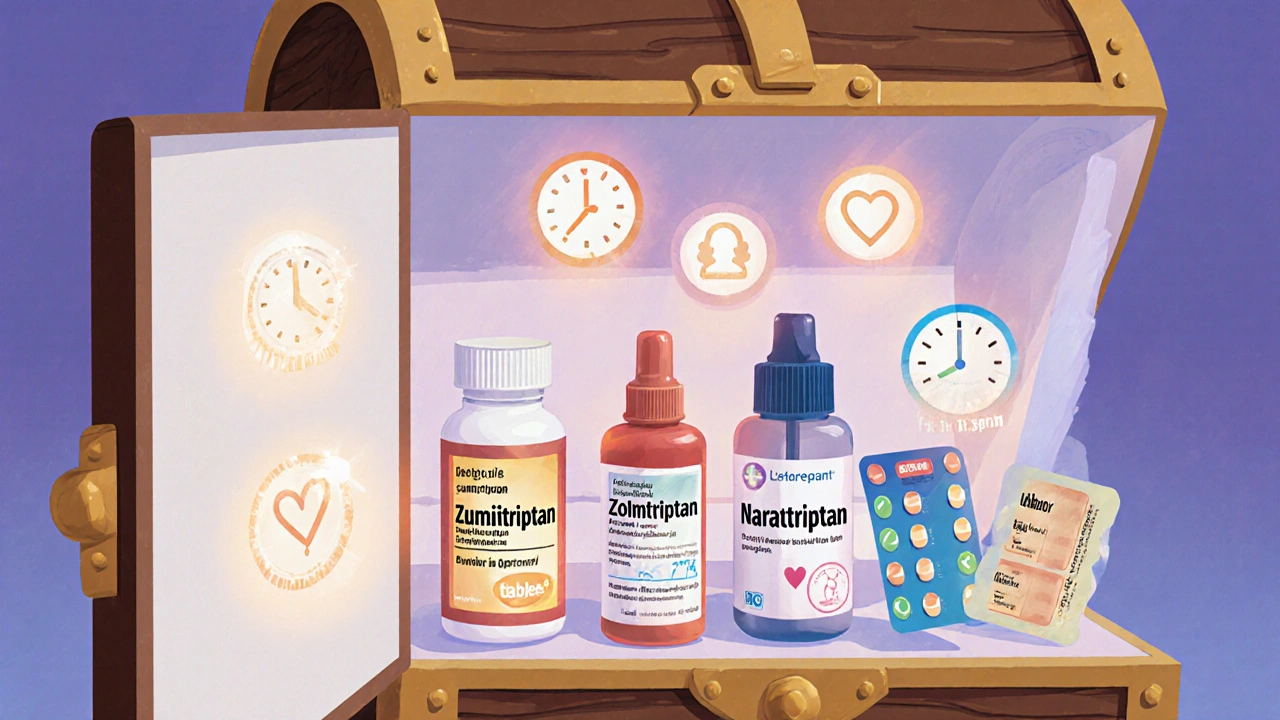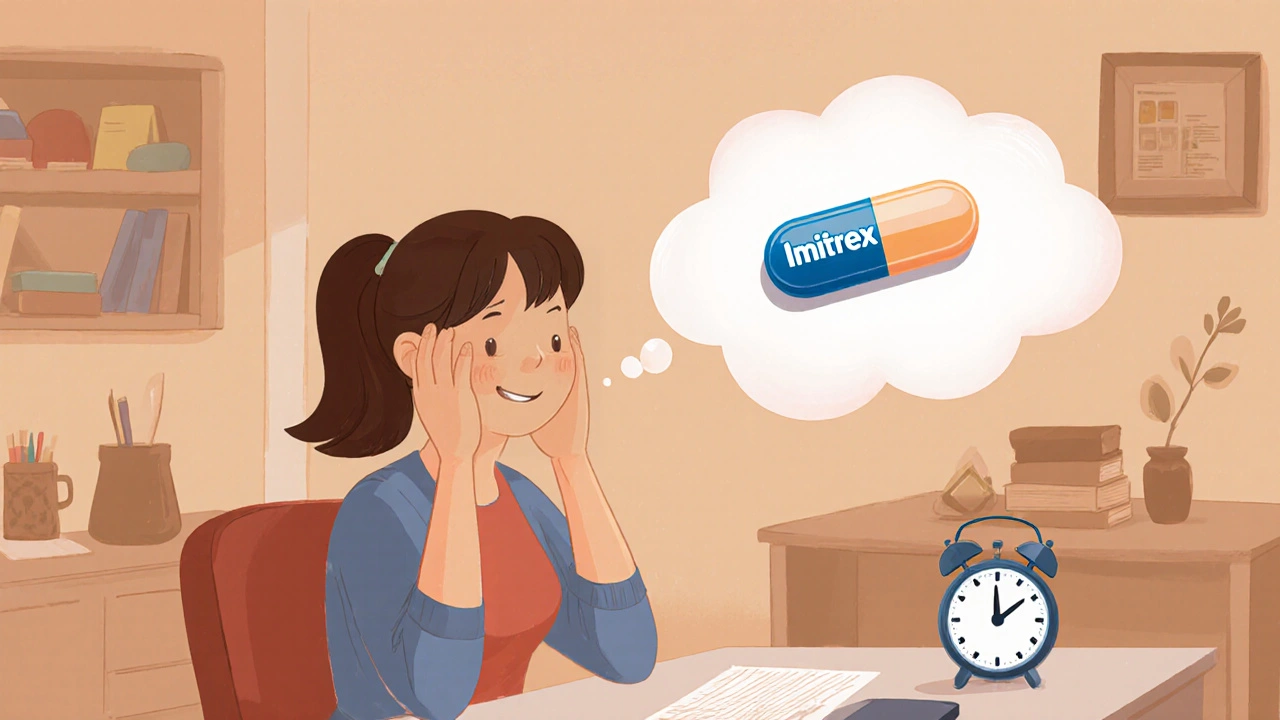Migraine Medication Recommender
Find Your Best Migraine Medication
Answer a few questions about your migraine experience and health profile to get personalized medication recommendations.
Your Health Profile
Recommended Medications
When tackling migraine, Imitrex (generic name sumatriptan) is a prescription triptan that works by narrowing blood vessels and blocking pain pathways. It’s been on the market for decades and is often the first drug doctors prescribe after lifestyle tweaks fail. But the migraine toolbox has expanded, and many patients wonder if another pill might work faster, cause fewer side effects, or fit better with their budget. This guide walks through the most common alternatives, lines up the pros and cons, and gives you a clear picture of which option might suit your migraine profile.
Quick Takeaways
- Imitrex starts working in about 30‑45 minutes and lasts 4‑6 hours; newer triptans can be faster or longer‑lasting.
- Non‑triptan options like lasmiditan and ubrogepant avoid vasoconstriction, making them safer for heart patients.
- Cost varies widely: generic sumatriptan is cheapest, while brand‑only newer drugs can be several times more expensive.
- Side‑effect profiles differ - triptans often cause tingling or tightness, while lasmiditan may cause drowsiness.
- Choosing the right drug depends on onset speed, duration, cardiovascular risk, and insurance coverage.
Understanding Migraine and the Triptan Family
Migraine is a neurological disorder characterized by throbbing head pain, nausea, and sensitivity to light or sound. During an attack, blood vessels in the brain dilate and inflammatory chemicals surge. Triptans, including sumatriptan, target the serotonin 5‑HT1B/1D receptors to reverse this dilation and block the pain signals.
While Imitrex belongs to the first‑generation triptans, newer agents were designed to improve onset, extend duration, or reduce cardiovascular strain. Below, each alternative is defined with its key attributes.
Key Alternatives Explained
Zolmitriptan (brand name Zomig) is a second‑generation triptan that can be taken as a nasal spray for faster absorption.
Rizatriptan (brand Maxalt) offers one of the quickest oral onsets-often within 20 minutes.
Naratriptan (brand Amerge) is known for a longer duration of relief, lasting up to 24 hours.
Eletriptan (brand Relpax) provides a balance of rapid onset and extended coverage, with a typical duration of 12‑24 hours.
Almotriptan (brand Axert) is often praised for its tolerability and once‑daily dosing for frequent attacks.
Lasmiditan (brand Reyvow) belongs to the 5‑HT1F agonist class, avoiding vasoconstriction altogether, which makes it safer for patients with heart disease.
Ubrogepant (brand Ubrelvy) is a CGRP receptor antagonist that works downstream of the trigeminal nerve, providing an option for those who cannot tolerate triptans.
Side‑Effect Snapshot
Every migraine drug comes with a trade‑off. Below is a quick look at the most common side effects for each option.
- Imitrex (Sumatriptan): Tingling, chest tightness, nausea.
- Zolmitriptan: Nasal irritation (spray), dizziness.
- Rizatriptan: Drowsiness, dry mouth.
- Naratriptan: Fatigue, mild muscle pain.
- Eletriptan: Dizziness, heaviness in the limbs.
- Almotriptan: Generally mild; occasional headache rebound.
- Lasmiditan: Somnolence, coordination problems.
- Ubrogepant: Nausea, abdominal pain.

Cost and Accessibility
Cost can be a make‑or‑break factor. Generic sumatriptan (Imitrex) typically runs between $5‑$10 per tablet with most insurance plans, while brand‑only options like Reyvow can exceed $300 for a single dose. Ubrogepant’s price sits around $150 per pill, though some pharmacy benefit managers have negotiated lower copays.
Availability also matters. Most triptans are listed on national formularies, whereas newer drugs may require prior authorization. Always check your specific plan before committing to a brand.
Head‑to‑Head Comparison Table
| Drug | Brand | Mechanism | Onset (hrs) | Duration (hrs) | Common Side Effects | Typical Dose |
|---|---|---|---|---|---|---|
| Sumatriptan | Imitrex | 5‑HT1B/1D agonist | 0.5 | 4‑6 | Tingling, chest tightness | 50‑100mg oral |
| Zolmitriptan | Zomig | 5‑HT1B/1D agonist | 0.3 (nasal) | 5‑8 | Nasality, dizziness | 5mg oral or 5mg nasal |
| Rizatriptan | Maxalt | 5‑HT1B/1D agonist | 0.33 | 6‑8 | Drowsiness, dry mouth | 10mg oral |
| Naratriptan | Amerge | 5‑HT1B/1D agonist | 1 | 12‑24 | Fatigue, muscle pain | 2.5mg oral |
| Eletriptan | Relpax | 5‑HT1B/1D agonist | 0.5 | 12‑24 | Dizziness, heaviness | 40mg oral |
| Almotriptan | Axert | 5‑HT1B/1D agonist | 0.5 | 6‑8 | Mild, occasional rebound headache | 12.5mg oral |
| Lasmiditan | Reyvow | 5‑HT1F agonist (no vasoconstriction) | 1 | 4‑6 | Somnolence, coordination issues | 50‑200mg oral |
| Ubrogepant | Ubrelvy | CGRP receptor antagonist | 0.75 | 6‑12 | Nausea, abdominal pain | 50mg oral |
How to Choose the Right Option for You
- Assess cardiovascular risk. If you have a history of heart disease, avoid triptans that cause vasoconstriction and consider lasmiditan or ubrogepant.
- Prioritize speed vs. duration. For fast relief, rizatriptan or nasal zolmitriptan are top picks. For long‑lasting coverage, naratriptan or eletriptan shine.
- Check insurance coverage. Generic sumatriptan is generally the cheapest; newer agents may need prior authorization.
- Watch for side‑effects. If you’re prone to dizziness, avoid eletriptan. If drowsiness is a problem, steer clear of lasmiditan.
- Consider dosing convenience. For multiple attacks a day, Almotriptan’s single‑dose regimen may be easier.
Talking to a neurologist or headache specialist can refine these general rules based on your migraine pattern, comorbidities, and lifestyle.

Potential Pitfalls and How to Avoid Them
- Medication‑overuse headache (MOH): Using any acute migraine drug more than 10 days a month can trigger rebound headaches. Keep a headache diary and limit acute use.
- Drug interactions: Triptans can interact with certain antidepressants (SSRIs, SNRIs) and cause serotonin syndrome. Always list all meds to your prescriber.
- Improper timing: Taking a triptan after the pain has peaked reduces effectiveness. Aim to dose at the first sign of aura or mild pain.
- Ignoring contraindications: Patients with uncontrolled hypertension should avoid triptans. Non‑vasoconstrictive alternatives fill that gap.
Real‑World Scenarios
Case 1: Young professional with fast‑onset migraines. Jane, 28, gets a migraine after long screens. She needs relief within 20 minutes to keep working. Rizatriptan’s 20‑minute onset and modest side‑effect profile make it her go‑to.
Case 2: Middle‑aged man with heart disease. Mark, 55, has stable angina. Triptans pose a risk, so his neurologist prescribes lasmiditan, which bypasses blood‑vessel narrowing and still blocks pain pathways.
Case 3: Frequent attacks, budget‑conscious. Ana, 42, experiences 8 migraines a month. She tries generic sumatriptan first because it costs under $10 per dose and provides reliable relief, then adds a nasal spray of zolmitriptan for the rare severe attacks.
Next Steps for Readers
1. Talk to your doctor. Bring this comparison sheet and discuss your cardiovascular health, attack frequency, and insurance coverage.
2. Start a migraine diary. Note onset time, medication taken, relief time, and any side effects. After a couple of weeks you’ll see which drug truly fits you.
3. Review your pharmacy benefits. Some plans prefer generic sumatriptan, while others may have a better copay for newer agents. A quick call to your insurer can save you dozens of dollars.
Frequently Asked Questions
Can I take Imitrex with other migraine drugs?
Mixing two acute migraine medications (like Imitrex plus rizatriptan) can increase side‑effects and the risk of serotonin syndrome. Usually doctors recommend one acute drug per attack and reserve a different class (e.g., ubrogepant) for a backup.
Is it safe to use a triptan if I have high blood pressure?
Uncontrolled hypertension is a contraindication for most triptans because they can cause vasoconstriction. If your blood pressure is well‑managed, some doctors may still prescribe a low‑dose triptan, but non‑vasoconstrictive options like lasmiditan are usually safer.
How fast does nasal zolmitriptan work compared to oral Imitrex?
Nasal zolmitriptan can begin relieving pain in 10‑15 minutes, whereas oral sumatriptan typically takes 30‑45 minutes. The spray bypasses the digestive system, giving it a speed edge, especially useful when nausea is present.
What should I do if my migraine returns after the medication wears off?
If symptoms recur within 24 hours, many clinicians allow a second dose of the same triptan after at least 2 hours, provided you stay under the daily maximum. If you need frequent repeat doses, discuss preventive therapy options such as CGRP monoclonal antibodies.
Are over‑the‑counter NSAIDs a good alternative to Imitrex?
NSAIDs like ibuprofen can help mild migraines but often fall short for moderate‑to‑severe attacks. They are safe for most people and cheap, making them a good first‑line option before moving to prescription triptans.


In the grand theatre of migraine treatment, sumatriptan stands as a venerable protagonist, yet its performance is not without critique. While its rapid onset garners applause, the lingering specter of cardiovascular contraindications dampens the ovation. Patients must weigh the melodramatic allure against the pragmatic constraints, lest they be ensnared in a tragic overture.
Imitrex is okay 😒 but honestly the side effects are overhyped
Honestly sumatriptan works for many, but you should also consider the newer triptans if you r looking for faster relief. Zolmitriptan nasal spray can hit the spot in 10-15 minutes, which is great when nausea is a problem. Just keep a headache diary and note any dizzyness or chest feeling. It helps you and your doc to fine‑tune the plan.
While the data clearly shows that generic sumatriptan is cost‑effective, some patients seem to ignore the obvious cardiovascular warning signs – a fact that should not be brushed aside. For those with heart concerns, alternatives such as lasmiditan present a safer profile. Choose wisely, and perhaps you’ll avoid unnecessary complications 🙂
Sounds solid, just try the generic first.
From a clinical perspective, the comparative table elucidates the nuanced pharmacokinetic differences among the agents. Notably, rizatriptan offers a rapid oral onset, while naratriptan provides an extended duration suitable for prolonged attacks. It is advisable to align the selection with both the temporal pattern of the migraine and the patient’s comorbid conditions.
I have been tracking my migraine triggers for years and I can tell you that the medication you pick matters more than you think. The first thing to consider is how fast you need relief. If you are at a desk and can’t afford downtime, a drug that works in 20 minutes is a game changer. Rizatriptan fits that bill nicely. On the other hand if your attacks last a full day you might want something that sticks around longer. Naratriptan gives you up to 24 hours of coverage. Cost is another factor that often gets overlooked. Generic sumatriptan is usually the cheapest option and insurance loves it. Newer brands can run into the hundreds per dose which can add up quickly. Side effects are also a big piece of the puzzle. Tingling and chest tightness are common with traditional triptans and some people can’t tolerate them. Lasmiditan avoids the vascular issues but brings drowsiness which may not be ideal for students or shift workers. Ubrogepant offers a non‑triptan pathway and is useful for those who have exhausted other options. Keep a diary of each migraine episode and note the time to relief, the duration of relief and any unpleasant sensations. Discuss those notes with your neurologist and adjust the regimen accordingly. Remember that medication overuse can create a rebound headache so limit acute doses to the recommended frequency.
Look, you can’t just pop any pill and expect miracles; taking a drug that can tighten your chest when you already have heart issues is downright irresponsible. Choose a medication that respects your body, not one that jeopardizes your health for a quick fix.
Indeed, the pharmacodynamics of triptans-particularly sumatriptan-are well‑documented in the peer‑reviewed literature; however, the layperson’s proclivity for sensationalized anecdotes often eclipses the nuanced understanding required for optimal therapeutic selection; consequently, it becomes imperative that we, as custodians of medical discourse, elevate the conversation beyond mere anecdote and toward evidence‑based rigor.
hey man i get it the cost can be a real pain but keep tracking which meds work best for u and talk to your doc they can sometimes get better deals the key is not to give up
Wow this guide really opened my eyes to the sheer variety of options out there for migraine relief and I’m amazed at how many factors you have to juggle when picking the right pill-speed of onset, duration, side‑effects, cost, insurance coverage, and even personal lifestyle preferences all play a part in the decision‑making process and it’s so refreshing to finally see everything laid out in one place without the usual jargon and confusion that usually plagues medical articles! I especially loved the part about nasal zolmitriptan because I’ve always struggled with nausea when taking oral meds and the idea of a spray that kicks in within minutes sounds like a game changer for my work days when I can’t afford to be sidelined by a headache. Also the emphasis on keeping a headache diary resonated with me because I’ve been dabbling in tracking apps and maybe I’ll finally commit to a proper log and share the data with my neurologist for a more tailored treatment plan. Overall kudos to the author for turning a complicated topic into something accessible and actionable-I’m definitely going to revisit this whenever I’m considering a switch in my medication regimen.
Your approach of balancing efficacy with safety is exactly what patients need; keep sharing these insights and you’ll help many navigate a confusing landscape.
In reviewing the comparative data, it becomes evident that each therapeutic class presents distinct pharmacological advantages; nonetheless, patient-specific factors must remain paramount in the selection process; hence, I encourage clinicians to integrate both clinical evidence and individual comorbidities when prescribing, and patients to engage in informed discussions with their providers 😊.
Okay folks, let’s cut the fluff and dive straight into the nitty‑gritty-if you’re sick of waiting forever for relief you need to grab a nasal spray or a rapid‑acting triptan like rizatriptan and get back to crushing your to‑do list; don’t let a migraine boss you around, own it, pick the right drug, and keep living your best life!
Oh great, another “miracle” drug that promises instant bliss-because we all know the pharma fairy will swoop in and fix everything, right? 🙄
Hey team, let’s remember that every migraine experience is unique, so keeping an open mind about both old‑school triptans and newer CGRP antagonists can lead to a more inclusive treatment plan-don’t be afraid to chat with your doc about mixing options if needed.
The article glosses over the serious risk of medication‑overuse headaches, presenting a dangerously optimistic view that could mislead vulnerable readers.
One could argue that chasing the perfect migraine pill is a Sisyphean task, forever rolling a stone of side‑effects uphill, only to discover that the summit is another prescription.